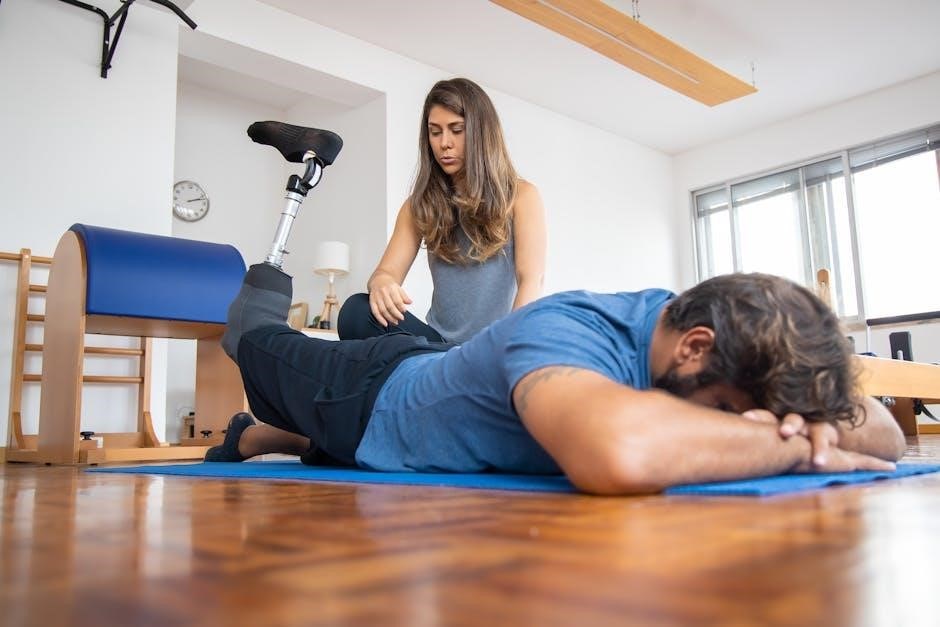Sciatica refers to pain radiating along the sciatic nerve‚ often caused by nerve compression or irritation. Symptoms include lower back pain‚ numbness‚ and tingling in the legs.
Understanding Sciatica: Definition and Symptoms
Sciatica is a condition characterized by pain‚ numbness‚ or tingling that radiates along the sciatic nerve‚ which runs from the lower back through the hips and down the legs. It occurs when the nerve is irritated or compressed‚ often due to a herniated disc‚ spinal stenosis‚ or muscle tension. Common symptoms include sharp or dull lower back pain‚ discomfort in the buttocks‚ and pain or numbness extending into one or both legs. Some individuals may also experience muscle weakness or difficulty moving the affected leg. Sciatica typically affects people between the ages of 45 and 64 and can worsen with prolonged sitting or certain movements. Accurate diagnosis is crucial to effectively manage symptoms and prevent further complications.
Common Causes of Sciatica and Risk Factors
Sciatica is often caused by compression or irritation of the sciatic nerve‚ commonly due to a herniated disc‚ spinal stenosis‚ spondylolisthesis‚ or piriformis syndrome. Aging‚ a sedentary lifestyle‚ and improper lifting techniques increase the risk. Obesity and poor posture can also contribute by placing additional strain on the lower back. People between 45 and 64 years old are most affected‚ as discs naturally degenerate with age. Prolonged sitting or repetitive movements may exacerbate symptoms. While most cases improve without surgery‚ understanding these causes and risk factors is essential for effective prevention and management. Addressing underlying issues through targeted exercises and lifestyle changes can significantly reduce sciatica recurrence and improve overall spinal health.

Sciatica Physiotherapy: Treatment Options
Sciatica physiotherapy focuses on personalized exercises‚ manual therapy‚ and patient education to alleviate pain and improve mobility. Tailored exercises address nerve tension and strengthen muscles.
Role of Physiotherapy in Managing Sciatica Pain
Physiotherapy plays a crucial role in managing sciatica pain by addressing the root cause of the condition. It combines targeted exercises‚ manual therapy‚ and patient education to reduce discomfort and improve mobility. A physiotherapist assesses the patient’s specific condition to design a personalized treatment plan‚ focusing on strengthening core muscles‚ enhancing flexibility‚ and improving posture. Techniques such as spinal mobilization and nerve gliding exercises can alleviate nerve compression and promote healing. Additionally‚ physiotherapy empowers patients with tools to manage pain independently‚ reducing reliance on medication and preventing future flare-ups. This holistic approach ensures long-term relief and restores functional movement‚ enabling individuals to resume daily activities without pain.
Exercise Therapy: A Core Component of Sciatica Treatment
Exercise therapy is a cornerstone of sciatica treatment‚ offering significant benefits for pain relief and functional improvement. It helps strengthen muscles‚ enhance flexibility‚ and improve posture‚ reducing nerve compression. A tailored exercise program‚ designed by a physiotherapist‚ addresses the underlying causes of sciatica‚ such as muscle imbalances or poor movement patterns. Techniques like stretching‚ strengthening‚ and low-impact aerobics are often combined to promote healing and prevent recurrence. Consistency is key‚ as regular exercise can reduce inflammation‚ improve mobility‚ and restore daily activities. By focusing on the root cause‚ exercise therapy not only alleviates symptoms but also supports long-term recovery‚ making it an essential component of managing sciatica effectively.
Best Sciatica Exercises for Pain Relief
Effective sciatica exercises include stretching‚ strengthening‚ and low-impact activities like swimming. These exercises target the lower back‚ hamstrings‚ and core to alleviate pain and improve mobility.
Stretching Exercises for Sciatica Relief
Stretching exercises are a cornerstone of sciatica relief‚ targeting tight muscles that compress the sciatic nerve. The Piriformis Stretch is highly effective‚ as it addresses the piriformis muscle‚ which often irritates the sciatic nerve. To perform this stretch‚ lie on your back‚ cross the affected leg over the other knee‚ and gently pull the unaffected leg toward your chest until a stretch is felt. Hold for 30 seconds and repeat 3 times. Hamstring stretches are also beneficial‚ as tight hamstrings can exacerbate sciatica symptoms. Sit on the floor with your legs extended‚ lean forward from your hips‚ and reach toward your toes. Additionally‚ the Cat-Cow Stretch improves spinal flexibility and relieves nerve pressure. Start on your hands and knees‚ arch your back (Cow Pose)‚ then round it (Cat Pose)‚ repeating for 10-15 repetitions. Always start slowly and consult a physiotherapist to tailor exercises to your specific condition.
Strengthening Exercises to Support the Lower Back
Strengthening exercises are essential for stabilizing the lower back and reducing sciatica symptoms. The Bird Dog exercise targets core and spinal muscles. Start on your hands and knees‚ extend one arm and the opposite leg‚ hold for 5 seconds‚ then lower. Repeat 10 times on each side. Pelvic Tilts strengthen the pelvis and lower back muscles. Lie on your back with knees bent‚ engage your core‚ and gently tilt your pelvis upward‚ holding for 5 seconds. Perform 15-20 repetitions. Superman exercises strengthen the erector spinae muscles. Lie face down‚ lift your arms and legs‚ hold for 5 seconds‚ and lower slowly. These exercises improve spinal stability and reduce sciatica pain when performed consistently. Always consult a physiotherapist to ensure proper form and effectiveness.

Advanced Sciatica Exercises and Techniques
Advanced sciatica exercises include swimming‚ Pilates‚ and yoga‚ focusing on core strength and flexibility. These techniques enhance spinal stability and reduce nerve compression effectively.
Pilates and Yoga for Sciatica Management
Pilates and yoga are highly effective for managing sciatica by improving core strength‚ flexibility‚ and posture. These practices focus on gentle movements that stabilize the spine and reduce nerve compression. Yoga asanas‚ combined with slow‚ conscious breathing‚ can alleviate back pain and sciatica symptoms. Pilates‚ meanwhile‚ targets the deep abdominal muscles‚ enhancing spinal alignment and reducing pressure on the sciatic nerve. Both methods emphasize controlled exercises that strengthen without exacerbating pain. For example‚ poses like Child’s Pose or Cobra Pose in yoga‚ and Pelvic Tilts in Pilates‚ are particularly beneficial. These techniques complement physiotherapy‚ offering a holistic approach to long-term sciatica relief and prevention of flare-ups.

Cardiovascular Exercises: Swimming for Sciatica
Swimming is an excellent cardiovascular exercise for managing sciatica‚ as it provides a low-impact‚ stress-free environment for the lower back and legs. The buoyancy of water reduces pressure on the spine‚ allowing for pain-free movement. Swimming works multiple muscle groups without overloading the sciatic nerve‚ promoting strength and flexibility. It also improves circulation‚ which aids in healing and reduces inflammation. Strokes like the freestyle or backstroke are particularly beneficial‚ as they engage the body without twisting or straining. Regular swimming can enhance cardiovascular health while supporting long-term sciatica management‚ making it a recommended activity in physiotherapy programs for those seeking non-invasive‚ effective relief from sciatica symptoms.
Preventing Sciatica Flare-Ups
Maintaining proper posture‚ incorporating ergonomic adjustments‚ and engaging in regular‚ tailored exercise programs can significantly reduce the likelihood of sciatica flare-ups and promote long-term spinal health.

Postural Awareness and Ergonomic Tips
Postural awareness is crucial in preventing sciatica flare-ups. Maintaining a neutral spine alignment during daily activities‚ such as sitting or lifting‚ reduces nerve compression. Ergonomic adjustments‚ like ensuring your chair height and monitor placement are appropriate‚ can minimize strain on the lower back. Avoid prolonged sitting by taking regular breaks to stretch and move. Strengthening core muscles through targeted exercises also improves spinal stability and posture. By incorporating these practices into your routine‚ you can significantly reduce the risk of sciatica recurrence and promote long-term back health.
- Avoid slouching or leaning forward for extended periods.
- Use supportive furniture and ensure proper workstation setup.
- Engage in regular stretching and movement breaks.
Progressive Exercise Programs for Long-Term Relief
Progressive exercise programs are essential for achieving long-term relief from sciatica. These programs focus on gradually increasing strength‚ flexibility‚ and spinal stability. They often begin with gentle stretches and core-strengthening exercises‚ then progress to more dynamic movements. Incorporating low-impact cardio‚ such as swimming or cycling‚ can enhance recovery without straining the lower back. It’s crucial to tailor exercises to individual needs and avoid activities that worsen symptoms. Regular practice helps improve posture‚ reduce muscle imbalances‚ and prevent future flare-ups. A physiotherapist can design a personalized program to ensure safety and effectiveness.
- Start with gentle stretches for the hamstrings and hip flexors.
- Progress to strengthening exercises for the core and glutes.
- Incorporate low-impact cardio for overall fitness.
- Monitor progress and adjust exercises as needed.
